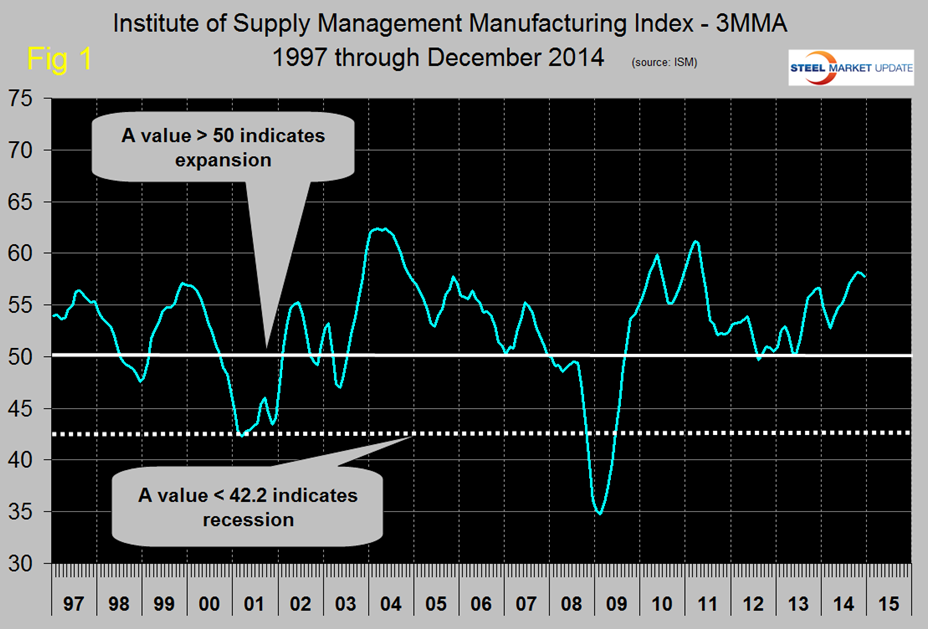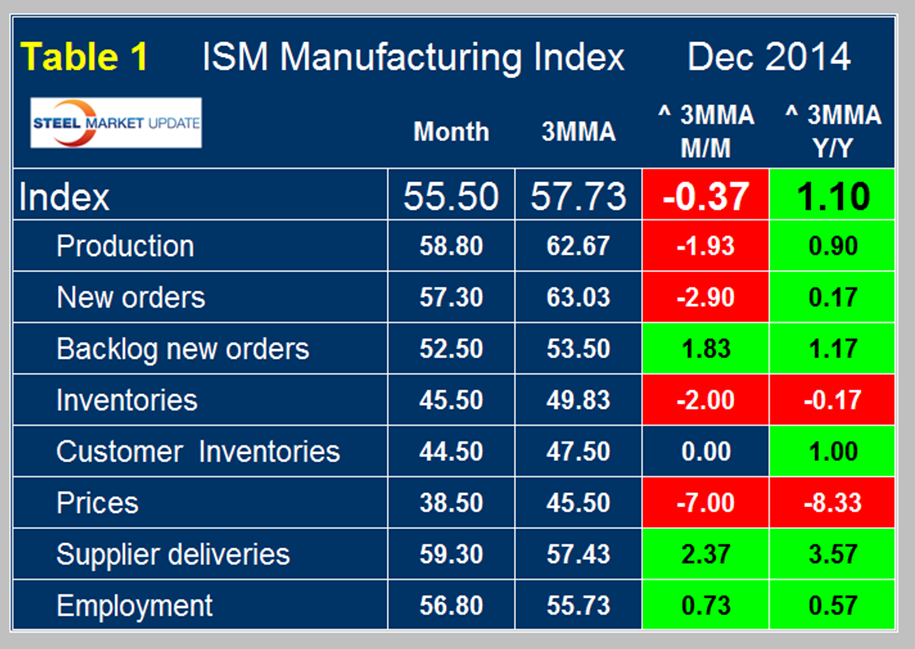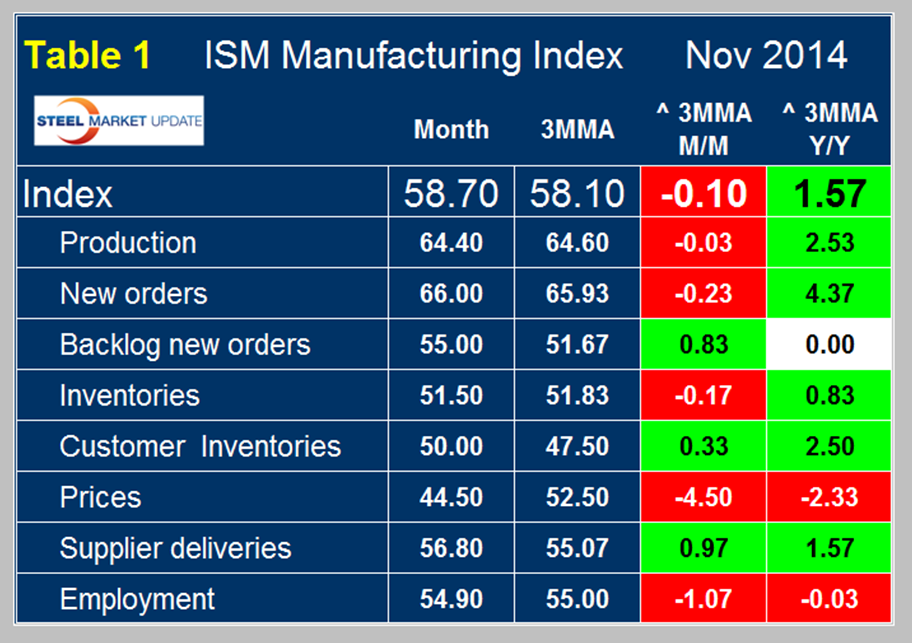Economy

ISM Manufacturing Index 3MMA Positive for 27th Consecutive Month
Written by Peter Wright
January 3, 2015
The ISM Manufacturing Index retreated again in December. The Institute of Supply Management released their December report on January 2nd and after the October surprise on the upside, the index slid back once again from 59.0 to 58.7 in November and to 55.5 in December, however this is still equal to the average for the year. The index has exceeded or equaled 60 only 14 times in the 166 months since January 1997 which is as far back as our data goes so the December reading is still strong.
Any number greater than (>) 50 indicates expansion and this was the nineteenth straight month for which this was the case. The three month moving average (3MMA) declined from 58.1 in November to 57.7 in December, this was the twenty seventh consecutive month of a value >50 in the 3MMA and the December value is still healthy by historical standards, (Figure 1).
Table 1 (December) shows the break down for December by sub component with the monthly result, the 3MMA, the growth of the 3MMA m/m and y/y for each.
We decided to change our written format this month to provide readers with a more expanded idea of the direction of the sub-components therefore have included here Table 1 (Nov) as published last month. Comparing these two versions of Table 1 shows that the growth of the 3MMA y/y slowed from 1.57 in November to 1.10 in December. The employment sub-component changed from negative in November to positive in December but the prices sub-component contracted once again in December.
The official news release reads as follows:
(Tempe, Arizona) — Economic activity in the manufacturing sector expanded in December for the 19th consecutive month, and the overall economy grew for the 67th consecutive month, say the nation’s supply executives in the latest Manufacturing ISM Report On Business.
The report was issued today by Bradley J. Holcomb, CPSM, CPSD, chair of the Institute for Supply Management® (ISM®) Manufacturing Business Survey Committee. “The December PMI registered 55.5 percent, a decrease of 3.2 percentage points from November’s reading of 58.7 percent. The New Orders Index registered 57.3 percent, a decrease of 8.7 percentage points from the reading of 66 percent in November. The Production Index registered 58.8 percent, 5.6 percentage points below the November reading of 64.4 percent. The Employment Index registered 56.8 percent, an increase of 1.9 percentage points above the November reading of 54.9 percent. Inventories of raw materials registered 45.5 percent, a decrease of 6 percentage points from the November reading of 51.5 percent. The Prices Index registered 38.5 percent, down 6 percentage points from the November reading of 44.5 percent, indicating lower raw materials prices in December relative to November. Comments from the panel are mixed, with some indicating that falling oil prices have an upside while others indicate a downside. Other comments mention the negative impact on imported materials shipment due to the West Coast dock slowdown.”
Of the 18 manufacturing industries, 11 are reporting growth in December in the following order: Printing & Related Support Activities; Fabricated Metal Products; Primary Metals; Furniture & Related Products; Food, Beverage & Tobacco Products; Petroleum & Coal Products; Textile Mills; Paper Products; Miscellaneous Manufacturing; Electrical Equipment, Appliances & Components; and Transportation Equipment. The six industries reporting contraction in December — listed in order — are: Plastics & Rubber Products; Wood Products; Machinery; Nonmetallic Mineral Products; Chemical Products; and Computer & Electronic Products.
Commodities Reports Up/Down in Price and in Short Supply:
Commodities Up in Price:
Aluminum* (11); Electric Components; Natural Gas; and Stainless Steel* (10).
Commodities Down in Price:
Aluminum*; Brass; Cardboard; Copper (5); Crude Oil (2); Diesel (3); Gasoline (3); HDPE Resin; Oil; Oil Based Products (2); PET Resin (2); Plastic Resin; Polypropylene Resin; Scrap Steel; Stainless Steel* (2); Steel; and Steel — Hot Rolled (2).
Commodities in Short Supply:
No commodities were reported in short supply.
Note: The number of consecutive months the commodity is listed is indicated after each item.
*Reported as both up and down in price.
Explanation: The Manufacturing ISM Report On Business® is published monthly by the Institute for Supply Management™, the first supply institute in the world. Founded in 1915, ISM exists to lead and serve the supply management profession and is a highly influential and respected association in the global marketplace. ISM’s mission is to enhance the value and performance of procurement and supply chain management practitioners and their organizations worldwide. This report has been issued by the association since 1931, except for a four-year interruption during World War II. The report is based on data compiled from purchasing and supply executives nationwide. Membership of the Manufacturing Business Survey Committee is diversified by NAICS, based on each industry’s contribution to gross domestic product (GDP). The PMI is a diffusion index. Diffusion indexes have the properties of leading indicators and are convenient summary measures showing the prevailing direction of change and the scope of change. A PMI™ reading above 50 percent indicates that the manufacturing economy is generally expanding; below 50 percent indicates that it is generally declining. A PMI™ in excess of 42.2 percent, over a period of time, indicates that the overall economy, or gross domestic product (GDP), is generally expanding; below 42.2 percent, it is generally declining. The distance from 50 percent or 42.2 percent is indicative of the strength of the expansion or decline. With some of the indicators within this report, ISM has indicated the departure point between expansion and decline of comparable government series, as determined by regression analysis.

Peter Wright
Read more from Peter WrightLatest in Economy

Steel groups welcome passage of budget bill
Steel trade groups praised the passage of the Big Beautiful Bill (BBB) in Congress on Thursday.

Industry groups praise Senate for passing tax and budget bill
The Steel Manufacturers Association and the American Iron and Steel Institute applauded the tax provisions included in the Senate's tax and budget reconciliation bill.

Chicago PMI dips 0.1 points in June
The Chicago Purchasing Managers Index (PMI) slipped 0.1 points to 40.4 points, in June.

Multi-family pullback drives housing starts to 5-year low in May
US housing starts tumbled in May to a five-year low, according to figures recently released by the US Census Bureau.

Architecture firms still struggling, ABI data shows
Architecture firms reported a modest improvement in billings through May, yet business conditions remained soft, according to the latest Architecture Billings Index (ABI) release from the American Institute of Architects (AIA) and Deltek.



